
First, I taped up a piece of Waterford 300lb paper onto my card board with masking tape. That helps it to keep the painting taut while being worked on, and gives it a somewhat neat border around it [sometimes paint can leak underneath it but it's going to be digitally trimmed anyway]. Then I start my sketch, trying to be as neat as possible, which is important because erasing isn't a nice thing to do.
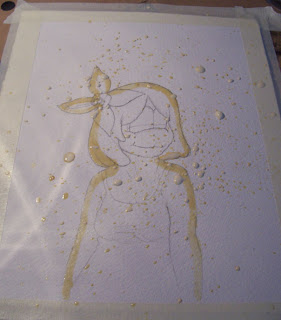
The next step is to apply masking fluid, which is a mixture of ammonia and latex and is used to protect certain parts of the paper from being painted on. You don't have to cover the whole character here, just around the edges, and I've flicked some about to make sparkles. A word of warning though: always use an old trashy brush to apply this stuff. It dries quickly to a sticky state on the brush and will not come off. It's also important to use a bottle within a year, otherwise it stains your paper with ugly yellow bits.
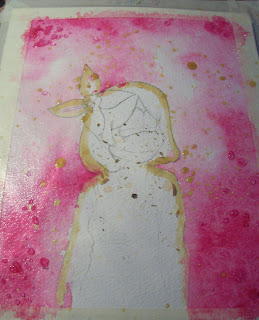
Now that the fluid is dry, I'll paint in the background with one colour. I painted it dry with a half-inch brush and then blended in some water. A few specks of salt were added, though I got impatient and used a hairdryer to dry it off. The masking fluid is then rubbed or peeled off, whichever is safest for your paper [it can tear sometimes], and now I'm ready to paint the character.
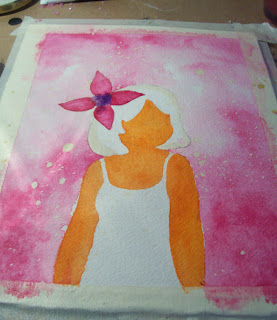
Here I started painting her skin and the fuchsia with a lot of colour. Most other artists use light washes and build it up, but I usually paint with thick colour depending on what colour a part is. The trick here is to work with that quickly but as neatly as possible, and to use an appropriate sized brush [here I used a size 2] to apply colour that's still wet. Texture can be added by lifting colour off with a wet tissue, the type you wipe your nose with as opposed to toilet paper.
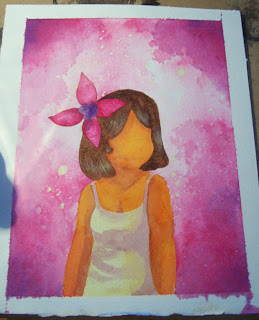
More parts of the drawing are filled in, and now I've started shading and highlighting. For the shading, I used violet paint, which works well with warmer colours. In fact, it works so well with wamer colours I added some around the edges of the background. For the initial highlights, I switch to a size 000 brush and paint in some white acrylic paint as lightly and carefully as possible. The masking tape is removed early as no more work is needed for the background.

Time to bring in another medium, gouache. This is like watercolour, but with white paint mixed in, making a much thicker paint. Recently I found it very effective to produce coloured lineart in a traditional piece, as opposed to colouring pencils and re-inking which I used to do and didn't make good enough results. The gouache I use it a bit too thick straight from the tube, so I mix it with water on a non-absorbant material [like this Fererro Rocher box I re-used] to make it flow better.
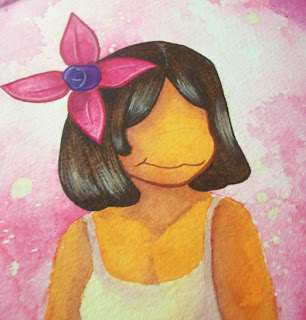
White watercolour paint is added instead of the acrylic ink to give more subtle highlighting, such as in the flower. If it's too light, it can be painted over. The lineart is applied as carefully as possible with the 000 brush.
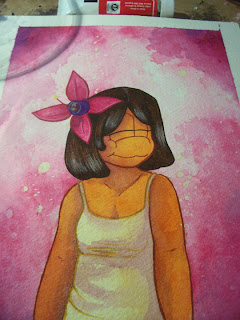
The lineart is done now, but I found that the yellow ochre I used for the nightie didn't look so good so I went over it with a 2H pencil, a HB is too dark for that. More shading is applied as well, but again this has to be done with care to avoid the gouache from running - dry gouache paint can be reused when water is used on it. I also started applying details, like the stigma of the fuchsia.

Final touches are added, like the design on the nightie which is painted in blue to add a little cool colour to a warm painting, and white speckles painted on with the acrylic ink. Since this is textured paper I'm using, I picked up a couple of colouring pencils and drew on certain parts to indicate scales, mainly on her face, chest and arms.
 And here is the final result. I hope that this tutorial is helpful and informative, and until I show up with another tutorial, happy painting!
And here is the final result. I hope that this tutorial is helpful and informative, and until I show up with another tutorial, happy painting!